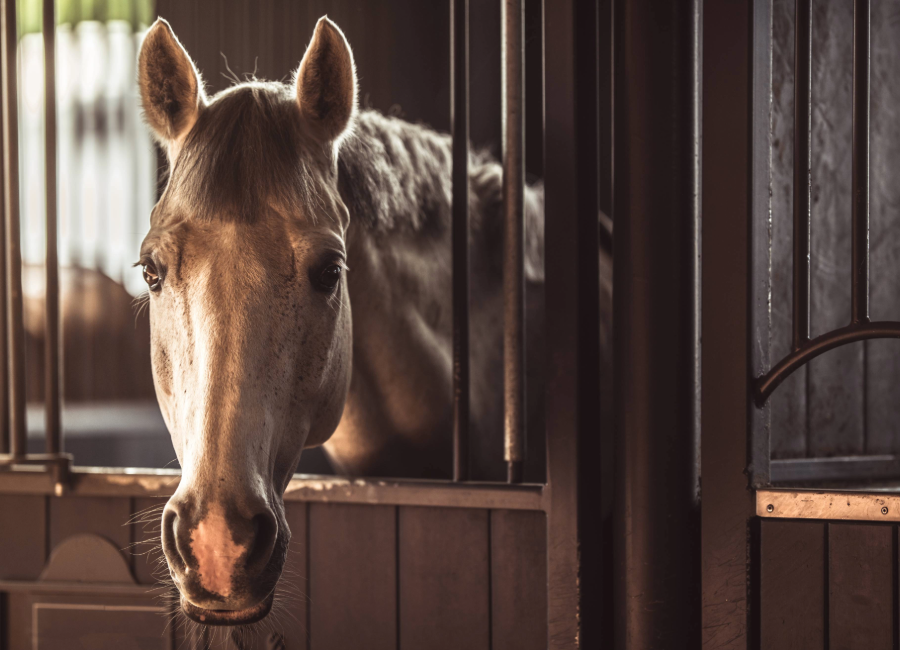Fall is here. Temperatures are dropping. And many of our horses will spend more time indoors.
Indoor stabling is convenient and sometimes necessary. But it’s not their natural habitat.
As herd animals, horses have physical, physiological and emotional needs that are naturally met living freely outdoors. Confinement can affect everything from respiratory and digestive heath to joint function and overall well-being.
Here’s 4 Tips for a healthy indoor season.
1. Improve The Air In There
Even when it’s cold out, let some air flow into the stable to remove or dilute airborne particles that are a major respiratory risk in the barn environment.
Horses are comfortable in much lower temperatures than people are. Providing there’s no chilling wind or significant moisture involved, temperatures around 0° are tolerable for most healthy horses for short periods.
The range between 18° and 59° is considered comfortable for most horses.
Horses’ long winter coats are designed to trap air against the skin and this creates a layer of insulation against the cold. Body-clipped horses can be blanketed to maintain warmth.
Good ventilation is a key consideration in the early stages of new barn design or renovation of an existing barn. Creating exit points for warm air to rise helps remove exhaled moisture and the active gases contained within it.
The more the difference in temperature between cold outside and warm inside air, the more powerful the effect of “thermal buoyancy” in keeping the barn air clean and healthy. Positioning barn windows and doors to take advantage of the site’s prevailing breezes sets the stage for effective, natural ventilation.
2. Leaf Blowers & Other No-Nos
Not using dust blowers around horses seems like a no-brainer, but veterinarians say that advice often goes unheeded.
Put horses outdoors when leaf blowing, or other dust-stirring activities like stall cleaning and aisle raking are planned.
The impact of barn activity on air quality was revealed in 2014 research comparing day and nighttime dust levels. Airborne particle concentrations during the day were nearly double that of concentrations measured at night. (Ivester et al., 2014).
Ensure that everyone involved in your horses’ care and barn maintenance understands the importance of minimizing dust-stirring activities when horses are inside. Signage to this effect can help keep the message top of mind.
3. Clean Bedding & Hay
Bedding and Hay are the biggest sources of harmful respirable dust in the stabled environment. Dusty hay and bedding are especially harmful because our horses spend much of their day with their nostrils hovering over both.
As the gateway to the respiratory tract, the nostrils allow invisible particles to infiltrate and irritate the lining of the upper airways and lungs. Inflammation and extra mucus result and this restricts the intake of oxygen and the outflow of carbon dioxide.
Dust-free bedding like Airlite cardboard bedding is an ideal choice. Made of pre-consumer cardboard, it’s free of contaminants and more absorbent than wood shavings. Importantly, it also neutralizes the ammonia odor that many consider a harmless component of horsekeeping.
Unfortunately, the presence of an ammonia odor indicates an already harmful level of a urine off-gas called “urea.” This is a respiratory irritant for horses and people. Airlite eliminates this irritant while providing a dust-free, dry, clean and cushy surface.
Hay is critical to our horses’ health because their digestive system was designed to process and absorb nutrients from long-stemmed forage. However, hay is naturally “dirty” with harmful microscopic particles. Hay “dust” can include mold, bacteria and other allergens.
Steaming or soaking hay will reduce these breathable particles.
Providing clean bedding and hay are smart steps for preventing respiratory problems and for managing horses who already suffer from conditions on the equine asthma spectrum.
4. E-x-t-e-n-d Mealtimes
Our horses’ digestive process was designed for spending most of their day grazing small bites of forage while roaming. That’s why their stomachs constantly produce acid that helps break down that forage for absorption. If there’s no forage in the tummy, however, the acid can irritate the stomach lining and cause ulcers.
Slow feeders approximate nature’s design to absorb nutrients while trickle feeding. More time eating means more chewing, which prompts more saliva that helps buffer the stomach from those acids. Four hours is generally considered the longest horses should go without something in their stomachs.
Plus, eating for more hours of the day is most horses’ favorite way to spend the day. There’s less time for boredom behaviors or food scarcity stress.





